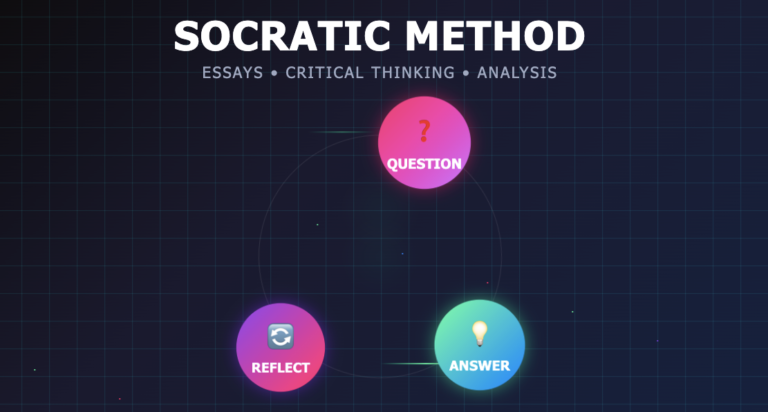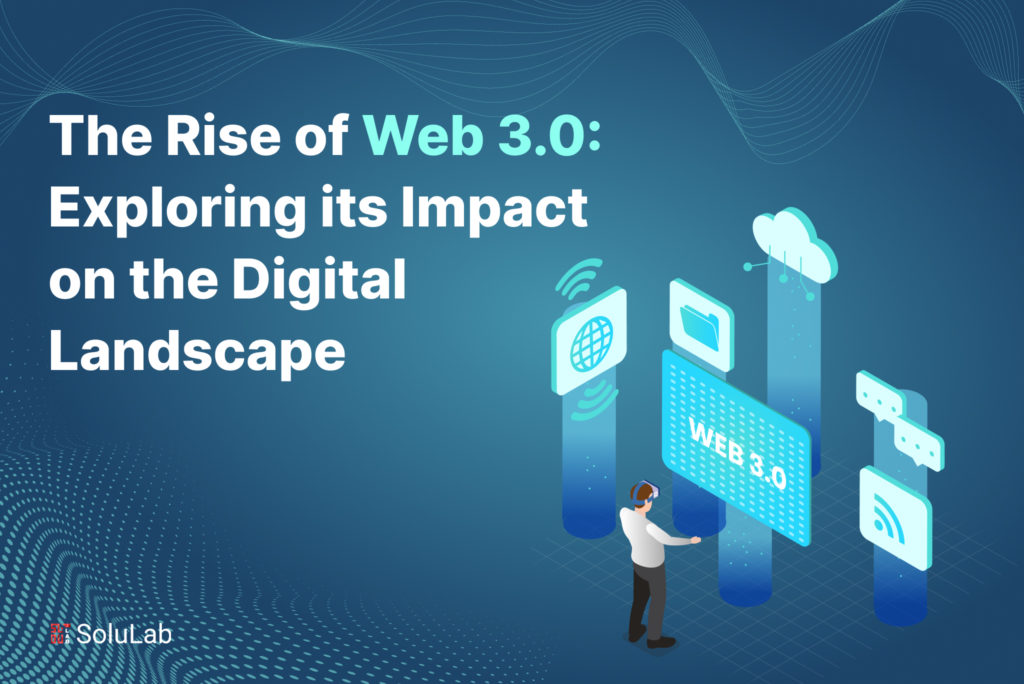
The internet has gone through a remarkable transformation from the very start. From the static web pages of the early days to the dynamic and interactive Web 2.0, the digital landscape has continually evolved. Now, we find ourselves at the dawn of a new era with the rise of Web 3.0, a paradigm shift in the way we interact with and understand the internet. In this article, we’ll explore the concept of Web 3.0 technology, its rise, projects, applications, and its profound impact on the digital ecosystem.
Read Our Blog Post: Top 10 Web3 Use Cases
Understanding Web 3.0 Technology
Before diving into the specifics of Web 3.0, it’s essential to understand the context and evolution of the Web. The term “Web 1.0” finds its roots in the initial days of the Internet when web pages were static and served as mere databases of information. This was followed by “Web 2.0,” which introduced a more interactive and dynamic web experience, characterized by social media, user-generated content, and the rise of platforms like Facebook, YouTube, and Twitter.
Web 3.0 represents the next step in this evolution, promising a web that is decentralized, intelligent, and capable of providing richer, more immersive experiences. It’s often referred to as the “semantic web” because it aims to make data and information not just accessible but also understandable to machines.
Key Technologies of Web 3.0
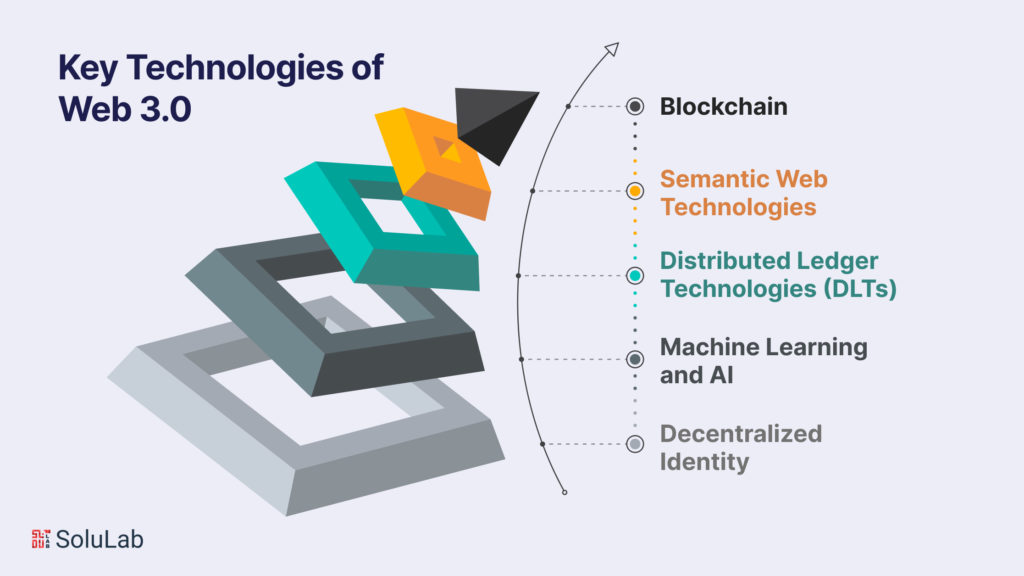
Web 3.0 integrates several key technologies and tools that are instrumental in realizing its vision. These technologies include:
-
Blockchain
Blockchain technology is at the core of Web 3.0’s decentralization. It provides a transparent and secure way to record transactions and manage data without relying on centralized intermediaries. Smart contracts, built on blockchain platforms like Ethereum, enable trustless, automated agreements and transactions.
-
Semantic Web Technologies
Semantic web technologies, such as Resource Description Framework (RDF) and Web Ontology Language (OWL), enable the creation of structured data that computers can understand and process. This semantic data forms the basis for more intelligent and context-aware applications.
-
Distributed Ledger Technologies (DLTs)
In addition to blockchain, other distributed ledger technologies play a role in Web 3.0. Directed Acyclic Graphs (DAGs) and Holochain, for example, provide alternative approaches to creating decentralized networks and applications.
-
Machine Learning and AI
Web 3.0 leverages machine learning and artificial intelligence to make sense of the vast amount of data generated on the internet. These technologies enable content recommendation, user behavior analysis, and predictive analytics to enhance the user experience.
-
Decentralized Identity
Web 3.0 introduces the idea of decentralized identity, where people have control over their digital identities. Decentralized identity systems, often based on blockchain, enable users to manage and verify their identity without relying on centralized authorities.
Key Concepts of Web 3.0
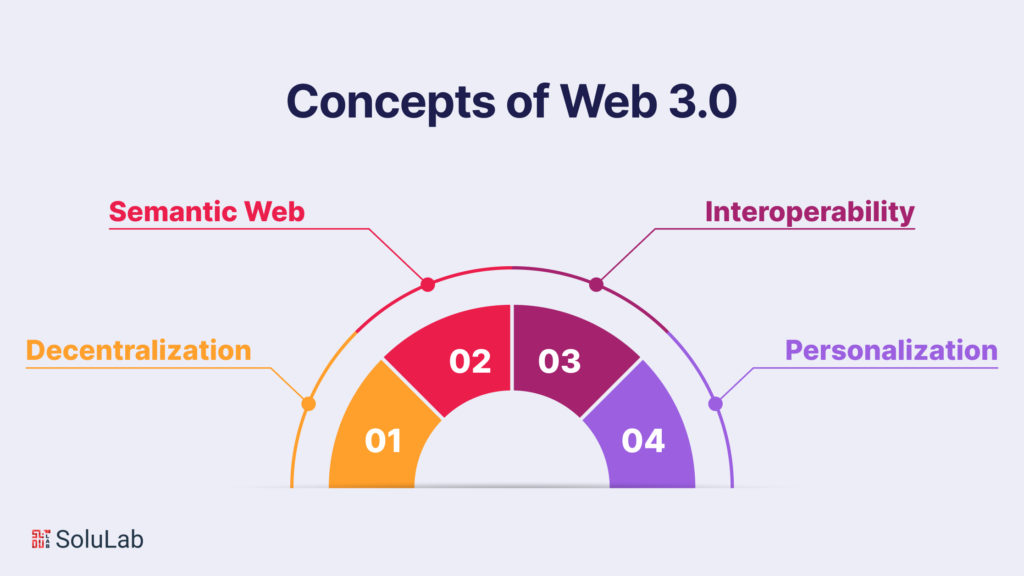
Web 3.0 integrates several key concepts and technologies that set it apart from its predecessors:
-
Decentralization
One of the fundamental tenets of Web 3.0 is decentralization. Traditional web systems rely on central servers and intermediaries, but Web 3.0 leverages blockchain and distributed ledger technologies to create a more peer-to-peer and trustless ecosystem. This decentralization reduces the control of a few powerful entities and promotes a fairer, more open digital landscape.
-
Semantic Web
Web 3.0 technologies focus on making data and information machine-understandable. This involves the use of semantic markup, ontologies, and linked data to enable better context and meaning extraction from content. This enables more intelligent search engines, recommendation systems, and data analysis.
-
Interoperability
Web 3.0 development trends emphasizes interoperability between various applications and platforms. This is achieved through open standards and protocols that allow different systems to seamlessly communicate and share data. As a result, users can have a unified experience across the web.
-
Personalization
Web 3.0 aims to provide highly personalized experiences for users. By leveraging artificial intelligence and machine learning, it can understand user preferences and behaviors to deliver content, services, and recommendations tailored to individual needs.
The Rise of Web 3.0
The concept of Web 3.0 has been in development for over a decade, and during this time, various projects have laid the groundwork for its emergence. Some early projects that contributed to the rise of Web 3.0 include:
- Ethereum: Ethereum, a blockchain platform, introduced smart contracts and decentralized applications (DApps). It played a significant role in popularizing the idea of decentralization and programmable money, which are central to the Web 3.0 vision.
- IPFS (InterPlanetary File System): IPFS is a distributed file system designed to create a more resilient and efficient web. It enables content to be stored and distributed in a decentralized manner, reducing reliance on centralized servers.
- Solid Project: The Solid project, led by Tim Berners-Lee, the inventor of the World Wide Web, aims to give individuals more control over their data. It enables users to store their data in “pods” and choose how and with whom to share it.
The Growth of Web 3.0 Applications
Web 3.0 technologies have led to the development of a wide range of applications that offer innovative solutions in various industries. These applications leverage decentralization, data intelligence, and interoperability to enhance user experiences. Some examples of Web 3.0 applications include
The growth of Web 3.0 applications has indeed been a transformative force in the digital landscape. Leveraging decentralized technologies and semantic understanding, Web 3.0 applications are reshaping various industries, most notably in decentralized finance (DeFi). As of September 2021, the total value locked in DeFi protocols had surpassed $100 billion, showcasing the rapid adoption and substantial investment in these applications.
Non-Fungible Tokens (NFTs) have also witnessed explosive growth, with notable sales, such as Beeple’s “Everydays: The First 5000 Days” artwork selling for a staggering $69.3 million in March 2021. These unique digital assets have opened new revenue streams for creators, artists, and game developers. The rise of Web 3.0 social networks, focusing on decentralized identity, data ownership, privacy, and security, is gaining traction as users increasingly seek control over their personal data.
Projects like Mastodon and Solid Social have garnered substantial interest as they represent a move away from centralized social media platforms. Furthermore, the integration of Web 3.0 technologies with the Internet of Things (IoT) promises enhanced security and interoperability, with global IoT spending projected to reach $1.1 trillion by 2023. In healthcare and education, Web 3.0 applications are poised to streamline processes and improve patient care and personalized learning experiences.
In brief, the Web 3.0 paradigm is redefining the digital landscape by empowering individuals, enhancing security, and fostering innovation, and its impact is becoming increasingly tangible with each passing day.
Web 3.0 in Healthcare
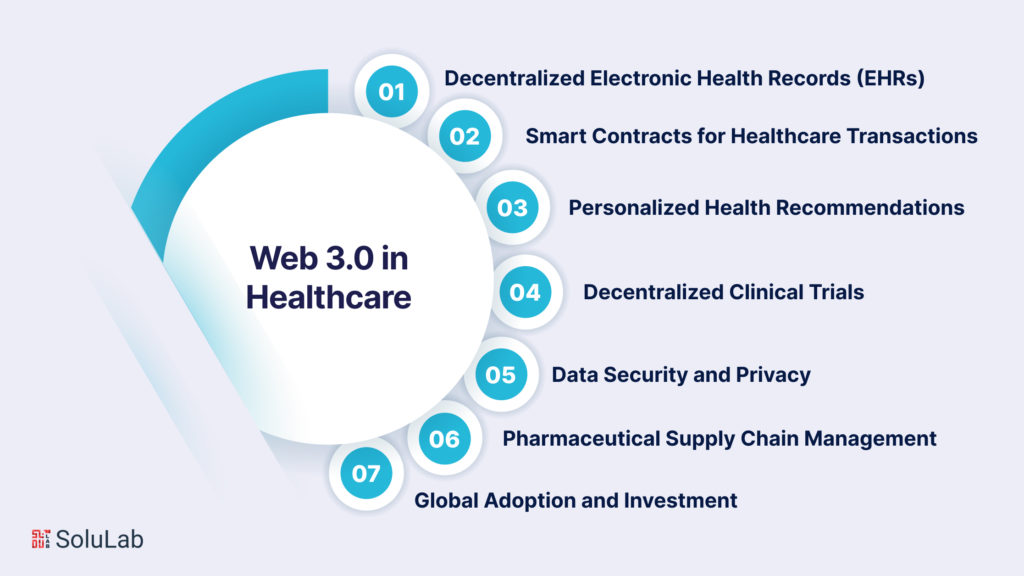
In the healthcare sector, Web 3.0 technologies promise transformative changes. Electronic Health Records (EHRs) can be securely stored and shared among healthcare providers and patients. Smart contracts can automate insurance claims and streamline healthcare payments. Additionally, personalized health recommendations based on user data become more accurate with machine learning and semantic web technologies.
The integration of Web 3.0 technology in healthcare represents a significant leap forward in the digital transformation of the medical industry. With its focus on decentralization, semantic understanding, and data interoperability, Web 3.0 promises to revolutionize patient care, data management, and the entire healthcare ecosystem.
-
Decentralized Electronic Health Records (EHRs)
Web 3.0 brings decentralization to electronic health records (EHRs), ensuring that patients have control over their health data. In a decentralized healthcare system, patients can securely access, manage, and share their medical records using blockchain technology. This eliminates the need for centralized data repositories and mitigates the risks associated with data breaches and unauthorized access. Decentralized EHRs also facilitate seamless sharing of health information among healthcare providers, leading to more comprehensive and efficient patient care.
Read Our Blog: Top 10 Web3 Development Companies
-
Smart Contracts for Healthcare Transactions
Smart contracts, a cornerstone of Web 3.0, are revolutionizing healthcare transactions. They enable automated and secure processes in areas like insurance claims and medical billing. For instance, when an insurance claim is submitted, a smart contract can automatically verify the claim’s validity, process payments, and update the patient’s medical records. This reduces administrative overhead, minimizes errors, and accelerates the payment process, benefiting both patients and healthcare providers.
-
Personalized Health Recommendations
Web 3.0’s semantic web capabilities, combined with machine learning and artificial intelligence, empower healthcare providers to offer highly personalized recommendations and treatment plans. By analyzing a patient’s medical history, genetic information, lifestyle, and preferences, these systems can provide tailored guidance for preventive care, medication management, and lifestyle improvements. The result is a more patient-centric approach to healthcare that can lead to better outcomes and reduced costs.
-
Decentralized Clinical Trials
Web 3.0 technology is disrupting the traditional clinical trial process. Decentralized clinical trials leverage blockchain and smart contracts to enhance the transparency and integrity of trial data. Patients can securely contribute their health data and monitor the progress of clinical trials while maintaining control over their information. This innovation increases patient engagement, accelerates trial recruitment, and minimizes data manipulation risks.
Read Also: Top 25 Blockchain-Based Gaming Companies
-
Data Security and Privacy
In an era of increasing data breaches and privacy concerns, Web 3.0’s emphasis on security and data ownership is particularly relevant in healthcare. With decentralized identity solutions and encrypted communication, patients can have greater control over their personal health information. Blockchain ensures that medical data is tamper-proof, while semantic web technologies enable secure sharing and interoperability without compromising patient privacy.
-
Pharmaceutical Supply Chain Management
Web 3.0 technology also enhances the pharmaceutical supply chain, ensuring the authenticity and transparency of medications from production to consumption. Blockchain-based solutions can track and verify the origins of pharmaceutical products, reducing the risk of counterfeit drugs and enhancing drug safety.
-
Global Adoption and Investment
The adoption of Web 3.0 in healthcare is gaining momentum globally. By 2023, it is estimated that the global healthcare blockchain market will reach $1.6 billion. This significant investment reflects the industry’s recognition of the potential of decentralized technologies to streamline operations, improve data security, and enhance patient care.
Read Our Press Release: SoluLab Bridging the Gap Between Technology And Innovation
The Web 3.0 Ecosystem
The Web 3.0 ecosystem is a dynamic and rapidly evolving landscape. It encompasses a variety of stakeholders, technologies, and services, all working together to bring the vision of Web 3.0 to life.
The Web 3.0 ecosystem represents a dynamic and rapidly evolving landscape that encompasses a wide range of stakeholders, technologies, and services, all working together to bring the vision of a decentralized and intelligent internet to life. Within this ecosystem, various elements collaborate to enable a new era of digital innovation and user empowerment.
Some key elements of this ecosystem include:
-
Web 3.0 Development Companies
Numerous companies specialize in Web 3.0 development. They offer expertise in blockchain, smart contract development, decentralized applications, and other technologies crucial to the Web 3.0 vision. These companies play a pivotal role in building the infrastructure and applications needed for the decentralized web.
-
Web 3.0 Platforms
Web 3.0 platforms provide the foundation for developing and deploying decentralized applications. Ethereum, Polkadot, and Cardano are among the prominent blockchain platforms that support the creation of DApps, while other platforms focus on specific niches or innovative features.
-
Web 3.0 Development Agencies
Web 3.0 development agencies offer a wide range of services, including consulting, application development, and smart contract creation. They help businesses and organizations navigate the complexities of Web 3.0 and bring their ideas to fruition.
-
Web 3.0 Development Services
These services encompass everything from blockchain development to data integration, semantic web implementation, and decentralized identity solutions. They are essential for building the infrastructure and applications that make Web 3.0 a reality.
Read Our Blog Post: Top Blockchain Technology Companies
-
Web 3.0 Development Solutions
Web 3.0 development solutions consist of software and tools that simplify the creation of decentralized applications. These include development frameworks, libraries, and development environments that enable developers to work efficiently in the Web 3.0 landscape.
The benefits of this ecosystem are becoming increasingly evident, as it fosters a more inclusive, secure, and personalized digital experience. Web 3.0 holds the potential to democratize access to digital assets, enhance data privacy and security, and open up new frontiers of innovation and collaboration. It empowers individuals and businesses to participate in the decentralized digital landscape, paving the way for a more open, intelligent, and interconnected internet. As the ecosystem continues to expand and mature, its influence will undoubtedly reshape the digital world, providing new opportunities and capabilities for a wide range of stakeholders.
Conclusion
In conclusion, the Web 3.0 ecosystem represents a pivotal moment in the evolution of the internet, marked by a shift towards decentralization, semantic understanding, and user-centric experiences. It offers a promising vision of a digital world where individuals have greater control over their data, transactions are trustless and automated, and personalization is at the forefront of online interactions. The adoption of Web 3.0 technologies, from blockchain to smart contracts and the semantic web, continues to gain momentum across various industries, including finance, art, healthcare, and education. As this ecosystem evolves and matures, it holds the potential to reshape the digital landscape, offering a more inclusive, secure, and intelligent internet experience for users and businesses alike.
The ongoing growth and development within the Web 3.0 ecosystem underscore the increasing recognition of the importance of decentralization, interoperability, and data security in the digital age. It not only empowers individuals but also fuels innovation, collaboration, and the creation of transformative applications and services that promise to redefine the way we interact with the digital world. As we navigate this decentralized digital frontier, it becomes clear that Web 3.0 is not just a technological evolution; it represents a fundamental shift in the way we approach the internet, and its potential for positive change is both exciting and transformative.
SoluLab, a prominent web3 development company, empowers enterprises to tap into the potential of Web3 with their premium development offerings. They utilize cutting-edge technologies to craft distinctive and advantageous solutions, drawing upon their proficiency in blockchain, smart contracts, and decentralized finance protocols.
SoluLab’s comprehensive Web3 Development Services equip clients to spearhead the creation of innovative decentralized applications, positioning them at the forefront of the constantly evolving Web3 landscape. Businesses now have the opportunity to enlist the services of SoluLab’s top-tier web3 developers to embark on a journey of constructing state-of-the-art solutions that propel growth and success. Get in touch with SoluLab today to explore their engagement models for recruiting freelance web3 developers or securing web3 development services.
FAQs
1. What is Web 3.0, and how does it differ from the previous web iterations (Web 1.0 and Web 2.0)?
Web 3.0 represents the next phase of the internet characterized by decentralization, semantic understanding, and data interoperability. It differs from Web 1.0, which was a static and informational web, and Web 2.0, which introduced interactivity and user-generated content. Web 3.0 integrates blockchain, smart contracts, and AI for a more intelligent, decentralized, and personalized digital experience.
2. What are some key technologies powering the Web 3.0 ecosystem?
Web 3.0 leverages technologies such as blockchain, smart contracts, semantic web technologies, artificial intelligence (AI), and decentralized identity solutions. These technologies enable decentralized applications, secure data management, and personalized user experiences.
3. How is Web 3.0 impacting the financial sector?
Web 3.0 is revolutionizing finance through Decentralized Finance (DeFi). DeFi platforms use blockchain and smart contracts to provide financial services without intermediaries, such as decentralized exchanges, lending and borrowing, and stablecoins. These innovations offer greater accessibility and transparency in the financial world.
4. What role do Non-Fungible Tokens (NFTs) play in the Web 3.0 ecosystem?
NFTs are new age digital assets representing ownership of digital or physical assets. They find applications in art, gaming, collectibles, and more. NFTs enable creators to monetize their work and provide a sense of true ownership in the digital realm.
5. How does Web 3.0 improve data security and privacy in healthcare?
Web 3.0 introduces decentralized electronic health records (EHRs) that give patients control over their health data. Blockchain ensures secure and tamper-proof data storage, while semantic web technologies enable secure sharing and interoperability without compromising patient privacy.
6. What is the significance of smart contracts in Web 3.0?
Smart contracts as the name suggests are self-executing agreements with the terms directly written into code. They automate various processes, reducing the need for intermediaries and improving efficiency. In Web 3.0, smart contracts are used in various sectors, from finance to healthcare, to facilitate trustless transactions.
7. How is Web 3.0 fostering innovation and collaboration within its ecosystem?
Web 3.0 encourages collaboration among development companies, platforms, agencies, services, and solutions. These entities work together to create a more inclusive, secure, and personalized digital experience. This collaborative approach drives innovation and the development of decentralized applications across various industries.





